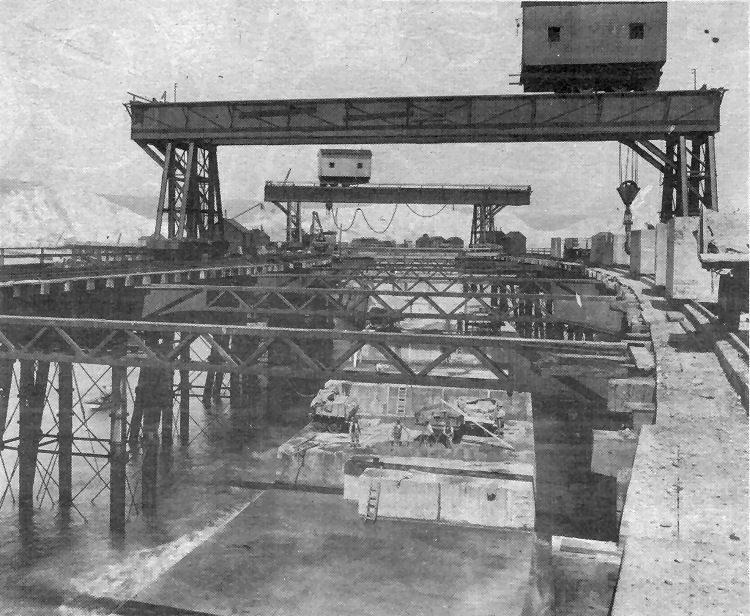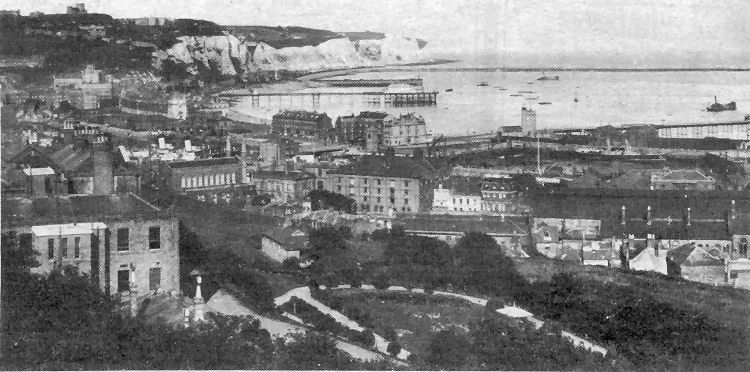Page Updated:- Sunday, 07 March, 2021. |
|||||
 Published in the Dover Express, 11 July, 1980. A PERAMBULATION OF THE TOWN, PORT AND FORTRESS. PART 95.
DUAL CONTROL The Dover Sea Front is now, and lone has been, under dual control, an arrangement which, in some cases, might work badly; but the Dover Harbour Board, the ground landlords, who have jurisdiction over the shore, and the Dover Corporation, who control the road and the bathing and boating regulations, have co-operated for the public good. But one development which caused a bitter controversy lasting many years, was the construction of a railway, only removed in recent years, which carried steam-hauled wagons of coal along the sea front from the Eastern Arm to the main line at Strond Street. The line was laid in 1918 for war purposes but in 1923 was given parliamentary sanction. Prom time to tune great improvements to the sea front have been made by both the local council and the Harbour Board. In 1850. owing to the inroads of the sea caused by the building of the Admiralty Pier, the Board commenced the building of a strong sea wall along the length of the Esplanade over which their jurisdiction extends, to the small jetty between Marine Parade and East Cliff.
EAST CLIFF From the East Cliff jetty to the Castle jetty, the shore was left with but little protection, except the accumulation of shingle; and this having been gradually swept away, it became necessary to erect sea defences there, which were carried out by the Dover Town Council, under the East Clill Sea Defences Act of 1877, the adjoining owners of property and the military authorities, being specially rated for that purpose. Sixty years later, when owners were in possession, many ignorant of their liability, there was great agitation to have the Act repealed. The Act not only made the owners liable to contribute io the cost of making the defences but also their maintenance. It was claimed their maintenance was of benefit to the town as a whole and in 1956 the contributory provisions of the Act were repealed, the owners paying £430 towards the cost of repealing the Act. When East Cliff (i.e.. the land under the Castle Cliff) was first built upon, it was considered to be extra-parochial, but it subsequently became a civil parish. It was a very small parish and ceased to exist as such when the Local Government Act of 1894 resulted in Dover becoming one civil parish. The houses built beyond East Cliff, at Athol Terrace, were also, for a long time, considered extra-parochial, thereby escaping payment of rates; but, on the 9th April, 1847, the question was tested at the East Kent Quarter Sessions, when, after hearing twenty witnesses it was decided that the houses were in the parish of Guston, This state of things remained in being for .many years although for municipal purposes the houses were in the borough of Dover.

Massive Goliath cranes dwarf workmen engaged on the construction of the Breakwater in April 1905, Lined up on the staging on the right, ready to be lowered into position, are some of the concrete blocks each weighing 42 tons and measuring lift Sins long, 7ft Gins wide and 6ft deep. Each was dated and numbered in the block-making yards at Shakespeare Beach and East Cliff, until these blockyards were created the blocks were made at Sandwich. Before the blocks could be laid on the seabed an extensive system of staging had to be built to carry the cranes and this required the importation of one of the world’s heaviest timbers 13,000 miles from Tasmania. Timber piles which formed the main framework were up to 100ft long.

The picture, above, depicts the Royal Mail and Temperance Hotels In Strond Street, the Esplanade Hotel and adjoining houses — now demolished — near the Clocktower, the Promenade Pier with its pavilion and the Eastern Arm before the submarine pen jetty was built.
|
|||||
|
If anyone should have any a better picture than any on this page, or think I should add one they have, please email me at the following address:-
|
|||||
| LAST PAGE |
|
MENU PAGE |
|
NEXT PAGE | |